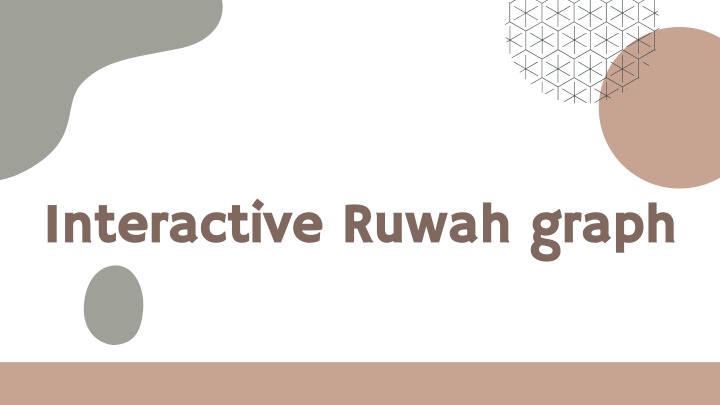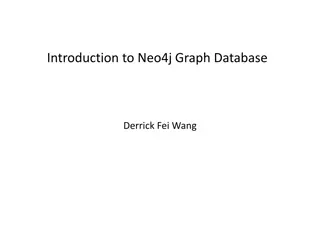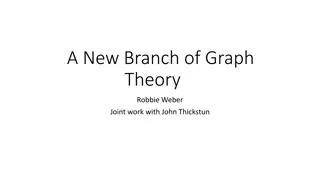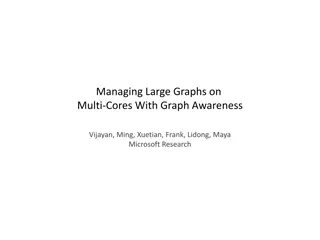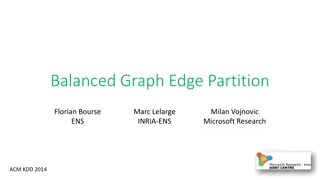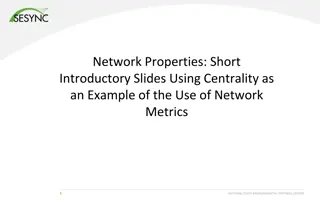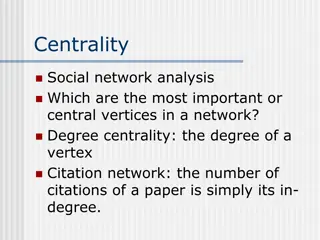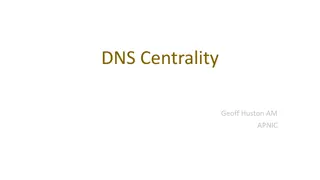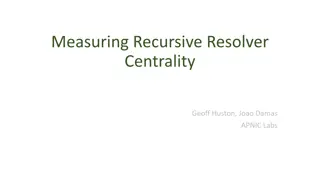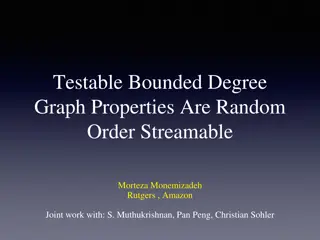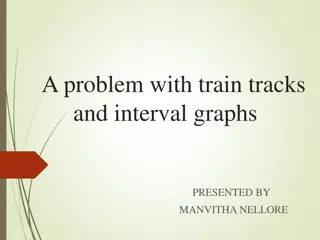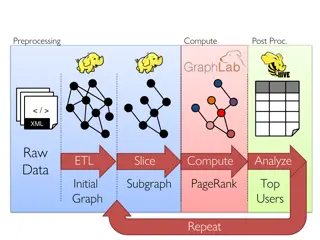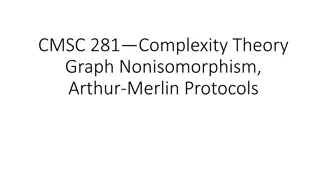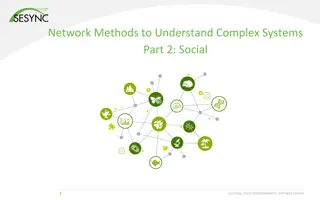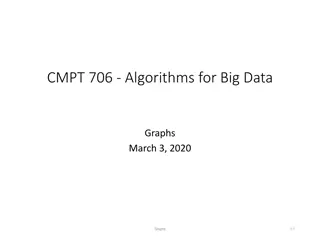Interactive Ruwah Graph Analysis: Centrality Measures and Related Work
With advancements in Information Technology, the generation of large data sets has led to a need for extracting historical data for various applications. This presentation delves into the domain of Hadith studies, exploring the construction of connected graphs for Ruwah and the application of graph centrality measures such as Betweenness, Closeness, and Eigenvectors. It also discusses related work on automating Hadith Sanad processing to aid in discerning accepted from rejected Hadiths. The work emphasizes features like search mechanisms, visualizing Ruwah sets, interacting with constructed graphs, and computing graph centrality measures.
Download Presentation

Please find below an Image/Link to download the presentation.
The content on the website is provided AS IS for your information and personal use only. It may not be sold, licensed, or shared on other websites without obtaining consent from the author.If you encounter any issues during the download, it is possible that the publisher has removed the file from their server.
You are allowed to download the files provided on this website for personal or commercial use, subject to the condition that they are used lawfully. All files are the property of their respective owners.
The content on the website is provided AS IS for your information and personal use only. It may not be sold, licensed, or shared on other websites without obtaining consent from the author.
E N D
Presentation Transcript
Interactive Ruwah Interactive Ruwah graph graph
T This presintation contains his presintation contains 01 03 introduction SYSTEM ARCHITECTURE 01 01 03 03 05 05 introduction introduction SYSTEM SYSTEM ARCHITECTURE ARCHITECTURE - Data base. - Ruwah graph building. CENTRALITY CENTRALITY MEASURES MEASURES - Closeness centrality - Betweenness Centrality - EigenValue 02 Realted work 02 02 04 04 06 06 Realted work Realted work INTERACTING INTERACTING WITH THE WITH THE GRAPH GRAPH CONCLUSION CONCLUSION
INTRODUCTION INTRODUCTION
With the continuous achievements in Information Technology and its applications in different life fields, huge amounts of data are generated Requesting data from historical warehouse is needed in several application. Prophet Mohammad (Peace Be Upon Him) talks are considered an important source. The way these Ahadith are saved is by memorizing.
Each Hadith is formed of two parts: 1. The Sanad (the list of Ruwah who participated in narrating the Hadith). 2. The Matn: the talk it self. This work is related to build up a connected graph for Ruwah. The work is related to apply a set of graph centrality measures like: Betweennes, Closeness and Eigenvectors.
O Outline utline Searching & Collecting data Graph Building documenting Centrality measurements Building data Base
RELATED WORK The authors investigated the opportunity to innovate an automatic Hadith Sanad processing that can help in automatic judgment of Hadith and distinguish between the accepted and rejected Hadith. 1. Itree the authors reported on a system that automatically generates the transmission chains of a Hadith and graphically display it. 2.
Our contribution in this work can be summarized as follows: a A simple search mechanism. Visualizing the set of Ruwah participating with the searched Rawi in narrating the searched Ahadith. The ability to interact with the constructed graph of narrators. The ability to compute a set of graph centrality measures.
SYSTEM ARCHITECTURE
Building the database
We constructed a database of 50 Ahadith as a sample. The database contains the list of narrators (Sanad) for those 50 Ahadith as well as the Ahadith (Matn) themselves. Moreover, for each Rawi, a list of related information are saved like: Date of Birth, Date of Death, the places where s/he lived in and his/her famous nickname.
Ruwah graph building
A set of programming techniques and codes were used in visualizing a graph on Ruwah. A JavaScript code with AJAX technique is used to handle the searching for some Rawi. pseudo code illustrates the process of graph visualization. Searching for some Rawi with a specified number of Ahadith.
getRawiName() getSanad(Rawi) array Sanad[ ] Graph object graph Display(graph)
INTERACTING WITH THE GRAPH
The nodes appear in the generated graph are clickable, in which a user can click one of the nodes to get information from the database regards the clicked node.
The nodes appear in the generated graph are clickable, in which a user can click one of the nodes to get information from the database regards the clicked node.
The nodes appear in the generated graph are clickable, in which a user can click one of the nodes to get information from the database regards the clicked node.
-The Small graph is also clickable and - Draw a small graph contains the has all the main graph properties. sannad for a hadith by clicking on it.
CENTRALITY MEASURES
these measures emphasize the activity of each Rawi in the process of Narration. for example, with the increase number of in- and out-bound of a given node, this means that the corresponding Rawi has more activity than others in the narration process. In this work, we computed three different centrality measures, mainly: Closeness, Betweenness and EigenValue.
Closeness centrality Closeness centrality In terms of Ruwah, it computes for every Rawi the amount of being closer to other Ruwah that is the Rawi with smallest Closeness means that this Rawi in average narrated most of his/her Ahadith with the minimum number of Ruwah.
Betweenness Centrality Betweenness Centrality A Betweenness value of a Rawi measures how many shortest narrations passes through the Rawi and this is important it means that the Rawi with the biggest value indicates his importance in narrating Ahadith and the trust worth s/he has
EigenValue EigenValue EigenValue quantifies the amount of Rawi importance for the number of narrations transmitted to or by him/her. The Rawi with bigger value indicates a high condense of in- and out-links to his/her corresponding node. In other words, EigenValue in important for sensitivity analysis.
CONCLUSION: - Sanad is the list if narrators involved in narrating the Hadith in which they form a path of narrators. - centrality measures were used to determine the impotence of each node in the graph
Acknowledgment Acknowledgment Working on this project gave us a lot of experience in web based projects and Data Base analyzes. It was a great opportunity, and for that we want to thank the people who helped us and made it easier for us to achieve our goal for this project. We thank All the Professors and lecturers who guided us through our learning process. Special Thanks to our graduation project supervisor Dr. Amjad Hawash who helped us guided us through every step of our journey, thank you for your patience and for all your advice. We want to express our deepest gratitude to our families, who we would not to be able to do this without their support.
Thanks Thanks Yara Bsharat Yara Bsharat Noor Dabeek Noor Dabeek Rama Jaber Rama Jaber CREDITS: This presentation template was created by Slidesgo, including icons by Flaticon, infographics & images by Freepik
